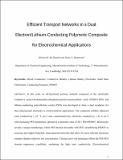Efficient Transport Networks in a Dual Electron/Lithium-Conducting Polymeric Composite for Electrochemical Applications
Author(s)
McDonald, Michael; Hammond, Paula T
DownloadAccepted version (1.108Mb)
Publisher Policy
Publisher Policy
Article is made available in accordance with the publisher's policy and may be subject to US copyright law. Please refer to the publisher's site for terms of use.
Additional downloads
Publisher Policy
Publisher Policy
Article is made available in accordance with the publisher's policy and may be subject to US copyright law. Please refer to the publisher's site for terms of use.
Terms of use
Metadata
Show full item recordAbstract
In this work, an all-functional polymer material composed of the electrically conductive poly(3,4-ethylenedioxythiophene):poly(4-styrenesulfonic acid) (PEDOT:PSS) and lithium-conducting poly(ethylene oxide) (PEO) was developed to form a dual conductor for three-dimensional electrodes in electrochemical applications. The composite exhibits enhanced ionic conductivity (∼10⁻⁴ S cm⁻¹) and, counterintuitively, electronic conductivity (∼45 S cm⁻¹) with increasing PEO proportion, optimal at a monomer ratio of 20:1 PEO:PEDOT. Microscopy reveals a unique morphology, where PSS interacts favorably with PEO, destabilizing PEDOT to associate into highly branched, interconnected networks that allow for more efficient electronic transport despite relatively low concentrations. Thermal and X-ray techniques affirm that the PSS-PEO domain suppresses crystallinity, explaining the high ionic conductivity. Electrochemical experiments in lithium cell environments indicate stability as a function of cycling and improved overpotential due to dual transport characteristics despite known issues with both individual components.
Date issued
2018-04Department
Massachusetts Institute of Technology. Department of Chemical EngineeringJournal
ACS Applied Materials & Interfaces
Publisher
American Chemical Society (ACS)
Citation
McDonald, Michael B. and Paula T. Hammond. "Efficient Transport Networks in a Dual Electron/Lithium-Conducting Polymeric Composite for Electrochemical Applications." ACS Applied Materials & Interfaces 10, 18 (April 2018): 15681–15690 © 2018 American Chemical Society
Version: Author's final manuscript
ISSN
1944-8244
1944-8252